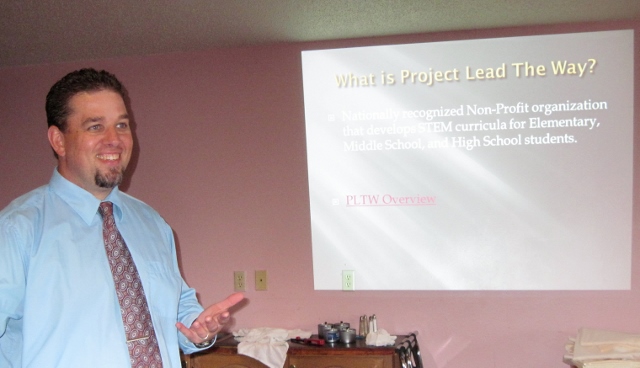Wahpeton High Engineering programs
Posted by Robert T. Chambers
on Mar 15, 2016
Robots are imaginary things in movies and engineering is what people do to mess with other people’s lives – right? Wrong – not only are they real but increasingly they are the future. The challenge for educators in the primary and secondary grades is to prepare students for the complexities of the twenty-first century. The traditional image of education (since the Middle Ages) has been a teacher standing in front of a class imparting their knowledge for the students to regurgitate. Not only does that model no longer work it has not worked for many decades. At their regular noon meeting at Prante’s on Tuesday March 16th member heard from the Wahpeton High School Principal Ned Clooten on the new district wide initiatives; specifically “Project Lead the Way” (PLTW). This is a new science, technology, engineering and math (STEM) curriculum to allow students to innovate and critically think taught in a different, more laboratory, environment. That this new curriculum is seen as important is the degree to which corporations nationally and locally have funded it as they a workforce prepared this way. By 2018 the number of STEM based jobs will increase by seventeen percent and 1.2 million of these jobs will go unfilled as the workforce is insufficiently educated. In North Dakota there are 8.6 STEM jobs for every one unemployed person and only 1.5 non-STEM jobs for each unemployed. For local corporations the opportunities are to invest in home grown talent; building high brand recognition; loyalty and giving them access to young and competent prospects as well as serving as an industrial role model for teachers and students. Mr. Clooten pointed to the North Dakota State College of Science (NDSCS) Tech Center as an example of “brands” cooperating in educating the workforce.

PLTW is a nationally based program involving Kindergarten through Grade 12. The “Launch” program involves K through Fifth Grade while the Sixth through Eight grades have the "Gateway" program with high school having three possible tracks: Engineering; Biomedical Science or Computer Sciences. The first three goals of each of these programs are: critical thinking; problem solving and design process. But what happened to reading, ‘riting and ‘rithmetic? They are there but have always been processes to allow the critical thinking and problem solving something that has been missed with the exception of students in the past who were lucky enough to have exceptional teachers who understood the need for developing critical thinking and problem solving skills; problems where the answers were not in the back of the book. The challenge for education leaders such as Clooten is to find teachers who can be trained to the new methods and bridge the gap. Just because someone has taught science for twenty years does not mean they can naturally adapt to the new methodology and even tolerate a certain amount of chaos in the classroom. Why the latter? Because students are moving about in a more “work environment” than sitting passively in their seats asleep – whoops I meant hanging on every word the teacher imparts. What is interesting is that students across the breadth of processing abilities adapt well and excel at PLTW programs. It also introduces students to programs such as engineering and bioscience about which historically the average high school student had only the faintest idea. In PLTW high school students are passed robotics; that is taught in middle school.
This is all funded by government – really – no it is not. Non-traditional funding methods need to be found. There is simply too much bureaucracy entrenched in old systems for government to give our students and industry a chance by bringing in the new methods. Change will be slow and take several generations by which time it may be too late as other countries better adapt and provide educated workforce. The labs and teacher training are very expensive something that this community is accustomed to hearing from the highly technical NDSCS. Thus corporations and individuals have stepped in. Locally Cargill has donated $30,000 thus the STEM workshop at the high school is named after them. ComDell has donated at the Gold Level (15,000); Minn-Dak -- the Silver Level (10,000); Giants Seeds -- the Bronze Level (5,000) and Pioneer Seeds at the Bronze Level (5,000). The State of North Dakota has been involved with funding but only as "matching grants' and thus has contributed $ 30,000. Individuals including parents of students who have graduated these programs and gone on to successful college and university studies have donated. Other corporations, organizations and individuals are encouraged to come aboard. Unfortunately many are waiting for government. Really - reading, ‘riting and ‘rithmetic needs a teacher, a notebook and a pencil.
Ultimately the goal is to have graduating students who can critically think and problem solve thus have a (proven) greater success opportunity in higher education or (proven) be more useful in the workforce. What government is missing is that better educated people provide a better workforce thus retain industries that pay tax and lower unemployment rates thus costs.
One of the more interesting interchanges during the question period was between Clooten and NDSCS Dean of Arts and Science Ken Kompelien where greater cooperation between the high school and the college was envisioned; a cooperation that Clooten admitted has been historically less than ideal. That members were interested and intrigued was shown by the nature of the questions asked and that the question period ran well after the scheduled adjournment time.
